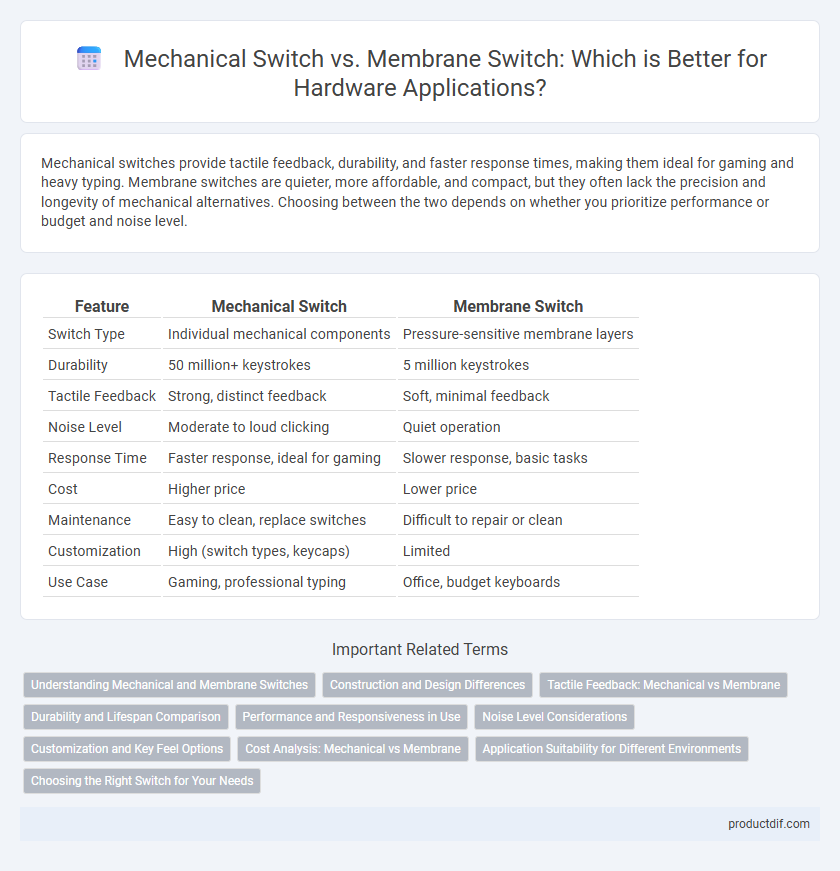Mechanical switches provide tactile feedback, durability, and faster response times, making them ideal for gaming and heavy typing. Membrane switches are quieter, more affordable, and compact, but they often lack the precision and longevity of mechanical alternatives. Choosing between the two depends on whether you prioritize performance or budget and noise level.
Table of Comparison
| Feature | Mechanical Switch | Membrane Switch |
|---|---|---|
| Switch Type | Individual mechanical components | Pressure-sensitive membrane layers |
| Durability | 50 million+ keystrokes | 5 million keystrokes |
| Tactile Feedback | Strong, distinct feedback | Soft, minimal feedback |
| Noise Level | Moderate to loud clicking | Quiet operation |
| Response Time | Faster response, ideal for gaming | Slower response, basic tasks |
| Cost | Higher price | Lower price |
| Maintenance | Easy to clean, replace switches | Difficult to repair or clean |
| Customization | High (switch types, keycaps) | Limited |
| Use Case | Gaming, professional typing | Office, budget keyboards |
Understanding Mechanical and Membrane Switches
Mechanical switches utilize individual moving parts and physical contacts to register key presses, offering tactile feedback, durability, and precision input favored in high-performance keyboards. Membrane switches rely on pressure pads with printed circuits underneath a flexible, airtight membrane, providing a quieter, cost-effective solution with limited key travel and softer feel. Understanding the design and functionality differences is essential for selecting the right switch for specific hardware applications based on performance, longevity, and user experience.
Construction and Design Differences
Mechanical switches feature individual physical components such as springs and metal contacts for each key, providing tactile feedback and durability. Membrane switches consist of pressure pads on flexible layers separated by a thin spacer, resulting in a flat, quiet design with limited travel distance. The construction of mechanical switches allows for greater customization and longevity, whereas membrane switches emphasize cost-effectiveness and compactness in design.
Tactile Feedback: Mechanical vs Membrane
Mechanical switches provide distinct tactile feedback with a noticeable click or bump, improving typing accuracy and responsiveness for users. Membrane switches offer a softer, less defined tactile sensation due to their rubber dome design, which can lead to a quieter but less precise keypress experience. The choice between mechanical and membrane switches significantly impacts user comfort and input efficiency in hardware devices.
Durability and Lifespan Comparison
Mechanical switches offer superior durability, often rated for 50 million keystrokes or more, significantly outlasting membrane switches, which typically withstand around 5 to 10 million keystrokes. The robust construction of mechanical switches uses individual spring-loaded mechanisms, providing consistent performance over prolonged use, while membrane switches rely on a rubber dome that can degrade and lose responsiveness faster. This difference in design results in mechanical switches being the preferred choice for high-usage environments demanding longevity and reliability.
Performance and Responsiveness in Use
Mechanical switches offer superior performance and responsiveness due to individual physical actuators beneath each key, ensuring precise tactile feedback and faster actuation. Membrane switches rely on pressure pads and conductive traces, which often result in less tactile feedback and slower response times. Gamers and typists typically prefer mechanical switches for their durability and consistent performance during rapid keystrokes.
Noise Level Considerations
Mechanical switches generate audible clicks during actuation, producing noise levels typically around 50-60 decibels, which can be distracting in quiet environments. Membrane switches operate with a soft, quiet keypress, emitting minimal noise often below 30 decibels, making them suitable for noise-sensitive settings. Evaluating noise level considerations is crucial when selecting switches for office spaces, gaming setups, or industrial applications where acoustic comfort impacts user experience.
Customization and Key Feel Options
Mechanical switches offer extensive customization options with a variety of tactile feedback, actuation forces, and audible clicks, enabling users to tailor key feel precisely to their preferences. Membrane switches provide limited customization, generally featuring a softer, quieter key press with less distinct tactile response. Mechanical switches are preferred in scenarios demanding diverse key feel options, while membrane switches suit applications prioritizing cost-efficiency and low noise.
Cost Analysis: Mechanical vs Membrane
Mechanical switches typically incur higher production costs due to individual moving parts and durable construction, whereas membrane switches offer a more cost-effective solution with simpler design and fewer components. The longevity and tactile feedback of mechanical switches justify the initial investment in high-end applications, while membrane switches provide affordable reliability suitable for budget-conscious projects. Overall, membrane switches present lower upfront expenses and maintenance costs, making them ideal for mass-produced consumer electronics.
Application Suitability for Different Environments
Mechanical switches excel in industrial and gaming environments due to their durability, tactile feedback, and high actuation lifespan, making them ideal for heavy-use scenarios. Membrane switches are preferred in medical devices, consumer electronics, and environments requiring moisture resistance and easy cleaning. Choosing between mechanical and membrane switches depends on factors such as environmental exposure, usage frequency, and required tactile response.
Choosing the Right Switch for Your Needs
Mechanical switches offer tactile feedback, durability, and precise actuation, making them ideal for heavy typing and gaming applications. Membrane switches provide a quieter typing experience with lower production costs and a slim profile, suitable for office environments and budget-conscious users. Selecting the right switch depends on factors like typing preference, noise tolerance, budget, and device usage frequency.
Mechanical switch vs Membrane switch Infographic

 productdif.com
productdif.com